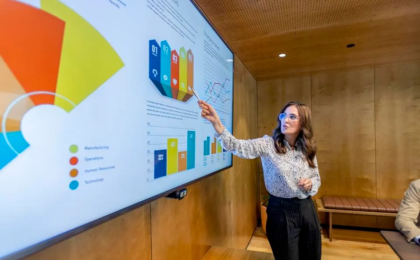Digital transformation is a business imperative for 2022 and beyond. Consider these three key areas to help ensure a successful strategy
Digital transformation: The term has been around for years but its meaning often remains vague and largely undefined, even for IT decision-makers.
As a result, in 2021, an estimated $700 billion in digital transformation spending fell short of delivering the desired results. Common reasons include an overwhelming number of applications in an organization’s tech stack, a lack of technical knowledge to deploy new solutions, and resistance from employees to adopt new digital technologies.
3 digital transformation initiatives to prioritize
So how can you ensure that your organization maximizes its digital transformation investment this year? Let’s break down some of the significant areas of focus and notable directions for transformation in 2022.
1. Customer experience
For the last two years, the pandemic has too often served as an excuse for poor customer service: A July 2020 poll by the Institute of Customer Service in the UK found that customer satisfaction was approximately 49% – the lowest number in 13 years.
In today’s business world, customer service is a key tenet for survival. The consumer experience should be front and center in digital transformation projects. In 2022, strive to significantly increase customer satisfaction ratings by removing excuses and setting the highest possible expectations of an exceptional customer experience (CX).
As consumers become more educated, more skeptical, and more impatient, a renewed focus on exceptional service will be integral to maintaining and growing your customer base. Many organizations check the top-priority box on CX, but few are prepared to follow through or even have plans in place to deliver. Put the “customer” back in your organization’s customer service by providing a better CX and greater transparency.
The Harvard Business Review illuminates how dynamic this sphere has become. Author Brian Solis writes, “An authentically customer-centric company serves customers by knowing them. Each discipline within the organization is no longer functioning in isolation, but more like a relay racer passing a baton: sharing the data, insights, and opportunities for personalization and enchantment. It’s an embrace of 360-degree data, insights, processes, systems, and organizational models to center on the customer.”
Such forward-thinking strategies will become necessary as digital markets continue to grow and reach nearly unfathomable sizes.
2. Security
Businesses, particularly those that do e-commerce and otherwise transact in the digital sphere, consistently rank cybersecurity as one of their two greatest concerns. Beyond the potential for financial and reputational damage, being held hostage by ransomware, hackers, and data breaches is a top fear for people worldwide.
Redouble your security efforts in 2022. Simply equipping computers with anti-virus software is no longer sufficient; endpoints (computers, servers, tablets, etc.) should be protected with more sophisticated EDR (endpoint detection and response) tools. Networks require Security Event and Incident Management (SEIM) with Security Operations Center (SOC) monitoring.
Hackers are always on the lookout for vulnerable smart devices, particularly given the sheer number in the hands of consumers. Predictive models and preparative capabilities across smart devices will need greater investment, staffing, and support.
3. Edge computing, 5G, and SD-WAN
Edge computing is a concept whereby compute resources are moved closer to end users. 5G is the next-gen broadband cellular network that is currently being rolled out by the major telecommunications providers. Software-defined wide-area networking (SD-WAN) is a technology that can increase performance (depending on the provider) and improve uptime with existing circuits. The end result is increased reliability.
All three technologies give customers a better experience through faster, more reliable connections. In turn, this allows customers to consume newer application technologies like autonomous vehicles, robotics, and virtual reality and to enjoy better and more reliable experiences with existing technologies.
For example, automobiles involved in accidents will be able to report damages immediately. Hospital monitors will disclose actionable data in near-real-time. Vehicles equipped with sensory devices will tell us if we can expect a delivery now or in nine minutes.
As businesses and the amount of readily available real-time data increases (Gartner predicts edge computing to grow to 75% by 2025), edge computing within digital business infrastructures will become necessary and ubiquitous.

















Wow, that’s what I was exploring for, what a material!
existing here at this website, thanks admin of this web page.
You will find more interesting articles thanks for your visit.
My partner and I absolutely love your blog and find most of your post’s to be exactly I’m
looking for. Do you offer guest writers to write content for
yourself? I wouldn’t mind composing a post
or elaborating on many of the subjects you write in relation to here.
Again, awesome web log!
Thanks for your blog, nice to read. Do not stop.
We are glad you liked it.
Check out our other post for more great content
Go to Army 365 Webmail by launching a new web browser (Microsoft Edge or Chrome; Firefox only if configured with ActivClient). your @army.mil email address Selected CAC/PIV SIGN IN. When prompted, choose the AUTHENTICATION certificate.
Description
Problem 5. If you have encountered any CAC enabled websites that have been working, recently stop working, please try adjusting your DNS. Some people are receiving an error message similar to this: “The DNS server might be having problems. Error Code: INET_E_RESOURCE_NOT_FOUND”
Thanks for sharing it certainly is helpful for some people. Feel free to visit our blog section for more interesting articles. https://digitalconsultingagencyllc.com/dca-articles/
I am truly thankful to the owner of this web site who has shared this fantastic piece of writing at at this place.
This design is wicked! You certainly know how to keep a reader entertained.
Between your wit and your videos, I was almost moved to
start my own blog (well, almost…HaHa!) Wonderful job.
I really enjoyed what you had to say, and more than that,
how you presented it. Too cool!